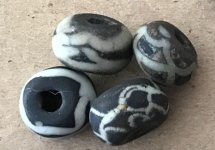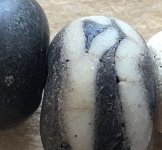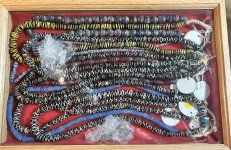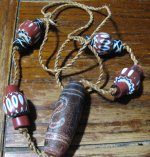I got out in the fields today, the very few around me could be hunted. Found nothing today.
But I did get a chance to visit a friend close to me who had some nice Native American relics and some early historic items which I will be posting. Many years ago he purchased a number of early historic items from a museum in Montana which was closing.
He is getting up there in years and is downsizing his collection. He has a lot to do in that area.
These are 17 Chevon beads, in amazing condition. Very old but the colors are vibrant for the age.
The earliest chevron beads, made in the 16th century, usually have seven layers, six hand-ground facets on the ends, and 12-pointed stars. From the late 16th century, chevrons were produced with fewer layers, four and six layers became the standard types in the 19th century. These exhibits the typical colors of the Venetian chevron bead: it has six layers of red, white, and blue.

But I did get a chance to visit a friend close to me who had some nice Native American relics and some early historic items which I will be posting. Many years ago he purchased a number of early historic items from a museum in Montana which was closing.
He is getting up there in years and is downsizing his collection. He has a lot to do in that area.
These are 17 Chevon beads, in amazing condition. Very old but the colors are vibrant for the age.
The earliest chevron beads, made in the 16th century, usually have seven layers, six hand-ground facets on the ends, and 12-pointed stars. From the late 16th century, chevrons were produced with fewer layers, four and six layers became the standard types in the 19th century. These exhibits the typical colors of the Venetian chevron bead: it has six layers of red, white, and blue.
Upvote
10











